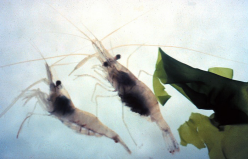|
 Grass
shrimp are the most common shrimp
inhabiting Barnegat Bay and are commonly found
in salt marshes, eelgrass beds and oyster reefs.
Their exoskeleton (shell) is usually clear and
almost transparent. Grass
shrimp are the most common shrimp
inhabiting Barnegat Bay and are commonly found
in salt marshes, eelgrass beds and oyster reefs.
Their exoskeleton (shell) is usually clear and
almost transparent.
Other names
include ghost
shrimp, shore shrimp, glass shrimp. Some
species can survive in fresh water and are very
adaptable to aquarium life.
Several species of
grass shrimp that can be found in the bay are so
similar in appearance that it requires extremely
close examination to accurately identify the
species.
 Examples
are: Examples
are:
- Marsh grass
shrimp Palaemonetes vulgaris
- Daggerblade
grass shrimp Palaemonetes pugio
- Brackish grass
shrimp Palaemonetes intermedius
Grass shrimp have
well-developed sense organs. They can easily
maneuver and swim in the water, but most
frequently are found crawling along the bottom
using their three pair of walking legs.
Grass shrimp are
omnivores and feed on a range of plants and
animals, including
detritus,
phytoplankton, and other small invertebrates
They grow to an
average size of 1 1/2 to 2 inches |
